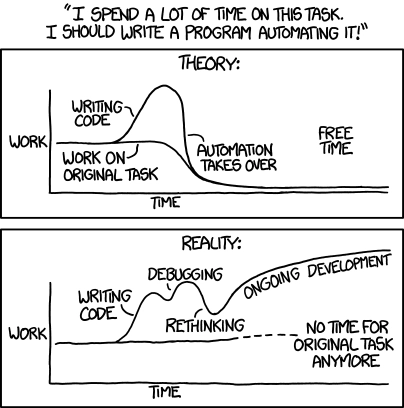Automatizing as many development steps as possible (from build to QA to deploy) is helping us a lot, but sometimes we write some code and then forget about it. This is a disaster! We have some bugfix or some new feature ready, but it is forgotten in some branch somewhere.
This is why we have, as policy, to push as soon as possible an to open a new MR, mark it as WIP, and assign to ourself; in this way Gitlab will remember to ourself we have a MR.
You need to do 3 steps to achieve that:
Push the code
Click on the link that appears on your terminal
Fill a form
But we are nerd. We are lazy. So one night, after a couple of beers, Alberto Urbano and I spent some hours to automatize a tasks that requires 10 seconds.
Actually, the experience was quite fun, it was the first time we used Gitlab APIs and we learned things we will apply to others scripts as well.

Image by Randall Munroe, xkcd.com
The script
With this script, every time we push a commit, Gitlab CI takes a look if the branch that commit belongs to has already a opened MR and, if not, it creates it. It then assigns the MR to you, and put WIP in the title to mark it as work in progress.
In this way you cannot forget about that branch, and when you’ve finished writing code on it, you just need to remove the WIP from the title and assign to the right person to review it.
In the end, this is the script we came out with (when you add to your project, remember to make it executable):
1#!/usr/bin/env bash 2# Extract the host where the server is running, and add the URL to the APIs 3[[ $HOST =~ ^https?://[^/]+ ]] && HOST="${BASH_REMATCH[0]}/api/v4/projects/" 4Gitlab CI
The variables used in the script are passed to it by our .gitlab_ci.yml file:
1stages: 2 - openMr 3 - otherStages 4All these environment variables are set by Gitlab itself, but the PRIVATE-TOKEN. A master of the project has to create it in its own profile and add to the project settings.
To create the personal token you can go to /profile/personal_access_tokens on your Gitlab instance, and then you add to your pipeline following this guide
Way to improve
The script is far from perfect.
First of all, it has 2 APIs calls, one to take the list of MR and one to take the default branch, to use it as target. Of course you can hardcode the value (in the end it shouldn’t change often), but hardcoding is always bad.
Also, it uses python3 to extract the name of the target branch - this is just one of many possible solutions, just use what is available on your system. Apart from that, the script doesn’t have any external dependency.
The other thing is how you need to set up the secret token to call the APIs. Luckily, Gitlab’s developers are working on a new way to manage secret token.
Conclusion
This was a very small and very simple example about how much powerful the Continuous Integration can be. It takes some time to setup everything, but in the long run it will save your team a lot of headache.
In fleetster we use it not only for running tests, but also for having automatic versioning of the software and automatic deploys to testing environments. We are working to automatize other jobs as well (building apps and publish them on the Play Store and so on).
Speaking of which, do you want to work in a young and dynamically office with me and a lot of other amazing guys? Take a look to the open positions at fleetster!
Kudos to the Gitlab team (and others guys who help in their free time) for their awesome work!
If you have any question or feedback about this blog post, please drop me an email at [email protected] :-)
Bye for now,
A. & R.
P.S: if you have found this article helpful and you’d like we write others, do you mind to help us reaching the Ballmer’s peak and buy us a beer?

Comments